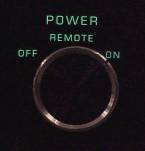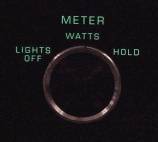Product Review - McIntosh MC-602 Two-Channel Power Amplifier - August, 2001
![]()
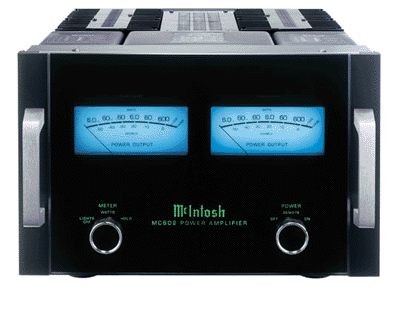 |
Specifications: Power: 600 Watts RMS per Channel into 8 Ohms, 4 Ohms, and 2 Ohms MFR: 20 Hz - 20 kHz Input Impedance: 10 kOhms Balanced or Unbalanced THD: 0.005% Weight: 155 Pounds |
|
McIntosh Laboratories, 2 Chambers Street, Binghamton, New York 13903; Phone 800-538-6576; Fax 607-724-0549; E-Mail [email protected]; Web http://www.mcintoshlabs.com |

|
Introduction
When I was a teenager back in the 1960s, my father bought a hi-fi system. He did not know anything about high-performance audio, but when I suggested that he get that extraordinary looking McIntosh in the demo room, he said, "Yes, McIntosh is the best." In those days, they were mostly tube amplifiers. But, having grown up during the Depression, he felt he could not afford what he thought was the best, so he purchased something else. When he retired, he told me that, by golly, he was not going to cut corners on the things he bought, and would get the good shrimp at the grocery store. But, I'll bet he wishes he had purchased that McIntosh 35 years ago.
McIntosh has been in business a long, long time. Everyone knows who they are. When Clarion (make of car hi-fi products) acquired them many years ago, some predicted that their quality would drop. But that did not happen. Why would a company (Clarion) spend millions of dollars to get a company with a prestigious name (McIntosh) and then let it go down the tubes? Nope, it didn't happen. McIntosh is still making some of the best amplifiers in the world.
The Design
The McIntosh MC-602 is a 600 watt rms per channel, two channel power amplifier. It weighs 155 pounds to prove it. There are 24 output transistors per channel, a 1.5 kVA toroidal transformer, four (two per channel) 27,000 �F capacitors, with � 70 Volts, for 265 Joules of energy storage total. It outputs 10 watts per channel in Class A, with the rest in Class A/B. 35 dB of negative feedback are employed. The amplifier is fully balanced from input to output.
On the rear panel (photo below), there are 12 massive speaker binding posts, with one pair per channel for 8 Ohms, 4 Ohms, and 2 Ohms connections. For inputs, there are balanced XLR and unbalanced RCA. A slider switch underneath the input jacks lets you choose the input connection. There is also a trigger input jack for automatically turning on the amplifier when you turn on a preamplifier that has trigger output voltage. The grounded AC cable is detachable.
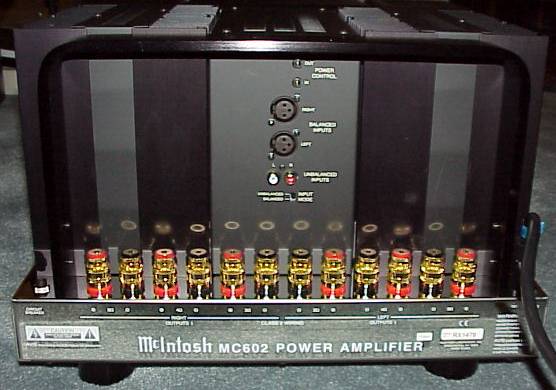
One thing that makes McIntosh amplifier designs very different from others is the use of output transformers. The photo below shows a top view of the MC-602. The front of the amplifier is to the right. The power toroidal is inside the rectangular metal case in the center, and the two output transformers are at the top and bottom. McIntosh calls them Autoformers� because there is only one winding, so it really is not actually a transformer. With a conventional push-pull amplifier, the + leg and the - leg may not output exactly the same voltage on a waveform. So, when you drive the amplifier to its limits, the lower voltage let will give out first, and the other leg can drive its extra voltage back into the leg that gave out. This can damage the amplifier. The use of the autoformer maintains absolute balance of the two legs. Secondly, regardless of how unstable the speaker load, the output transistors never see that instability when the autoformer is used.
Of course, the output autoformers have to be very good in order to pass a high bandwidth, not to mention 600 watts rms continuous, and that results in substantial cost. Well, the MC-602 is $8,000. Enough said.
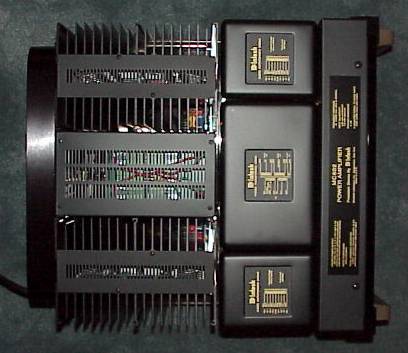
The front panel of the 602 is classic McIntosh. The power knob (photo below, left) and meter knob (photo below, right) are dials, not toggles or buttons. The meter knob controls what is one of the most distinctive looks in amplifiers, the McIntosh power meter (photo below). It indicates power output in watts (log) or dB. Notice that it goes all the way up to 2,400 watts. The 600 watt rating is continuous. It will output much more than that for short transients. The meter has a circuit that measures the voltage and current, and then calculates the actual power, so it does not matter what the impedance of the speakers is. If the meter moves too fast for you to catch that last explosion, set the dial to Hold, and the needle will stay at the peak output reading. You can turn the meter lights off if you like, but I can't imagine anyone wanting to do that. The blue backlighting look is just too cool!
|
|
|
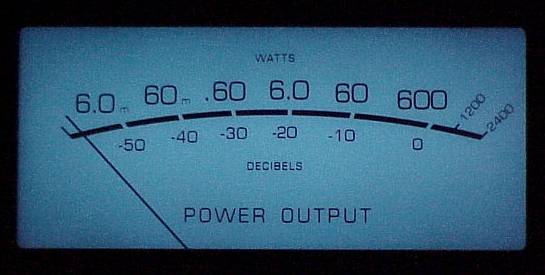
Other features include Power Guard, which keeps the 602 from going into clipping, although I can't see ever needing this to kick in. Maybe if you use it to weld your fender back on your car. There is also a thermal protection circuit in case the amplifier gets too hot. It ran very cool when I was testing it, but if you put it in a space that is too enclosed (not enough ventilation), I suppose this might activate sometime.
The Sound
I tested the MC-602 with all the kinds of speakers that most amplifiers hate, including some Carver Platinum Mark IV ribbons and Threshold ES-500 full range electrostatics. I used a McCormack CD transport and DAC, Balanced Audio Technology VK-5i preamplifier, and Nordost cables.
I have to say right off that if you are a consumer that just listens to piano music in the background while you read the newspaper, go get a 10 watt SET amplifier, because the MC-602 is made to rock the house. And that is what it did no matter what I threw at it. My favorite amp buster CD, "Fanfare for the Common Man" by Copland, on Telarc, has met its match. Sure, I could get that meter needle to tap on the 1,200 watt mark, but the only thing that had a problem was the sheet rock in the walls. The entire building moved. I was tempted to turn the volume up even another notch, but the speakers would have gone into orbit, and I might have had to take a trip to my ENT physician.
This amplifier will drive any speaker to its utmost capabilities. "The Great Fantasy Adventure Album" (Telarc) has tracks on it that most amplifiers will fear to tread, including the infamous crunching of T Rex, and Robin Hood's arrow. It is a wonderful demo disc, but I was sure I could see the MC-602 yawning while the cockroaches scattered for cover. It is a disc filled with theme music from numerous movies, and I felt like the orchestra was right there in the room.
This is not to say that the MC-602 won't do its stuff with regular ol' music at modest volume. Tony Bennett was as raspy as ever, and it sounded as though the entire wall was alive. Big ESLs and ribbons tend to do that, but it takes unshakable power to handle them. With the 602 in there, my speakers shook hands with the devil.
Telarc's new SACD of Tchaikovsky's "1812 Overture" is thunderous, with the climax utilizing 60 watts for the orchestra and chorus, and more than 600 watts for the cannons. It takes a big amp to handle this, and the 602 does it with ease.
Dukas' "La Peri" Fanfare (Telarc CD-80515-SA) has trumpets that must be heard to be believed. The 602 with the Carver ribbons was astonishing.
In "The Firebird" by Stravinsky (Telarc SACD-60039), the Introduction uses less than 1 watt, but the Finale requires much more than that. The 602 is just made for music like this.
The background of the 602 was completely silent. That is one of the nice things about fully balanced amplifiers. If you use the balanced input jacks, but have the slider switch set to unbalanced, the amplifier recreates one of the legs to feed the balanced circuitry, but you would not have the full value of Common Mode Rejection that balanced inputs have. Even so, it still sounds very quiet with the slider in the wrong position, so, remember to set it at Balanced when using the balanced jacks.
I brought a number of guests into the lab to show the MC-602 off. One of them begged me to put it in the trunk of his car. Similar requests from others who came and listened. "Too heavy to move it," I said.
I have seen some remarks on one other big McIntosh amplifier by another magazine, that it did not have quite the presence of product A or product B. Well, there are many variables that can affect this kind of subtlety, such as the preamp, the cables, and certainly the speakers, not to mention the sound preferences of the reviewer. I heard no such compromises with the 602 in our lab. And, when you crank things up, speakers usually deliver horrendous amounts of distortion. So, I have to say that at the kind of levels the MC-602 is made for, it has a sound unparalleled.
The use of 35 dB of negative feedback could be considered excessive by many people. I was surprised myself at that number. However, the fact that the amplifier sounded so extraordinary shows us that it is not the absolute amount of negative feedback that is employed, but how it is employed.
Conclusion
The MC-602 is the most powerful amplifier I have ever heard. For speakers that can take the kind of power it delivers, you will have a sound that you never imagined possible. It comes as close to reproducing music hall realism as you could ever want. Yeah, it's expensive, but why wait until you get to the point that you wish you had bought it way back when? Besides, those sexy power meters are incredible!
- John E.
Johnson, Jr. -
![]()
� Copyright 2001 Secrets of Home Theater & High Fidelity
Return to Table of Contents for this Issue.

